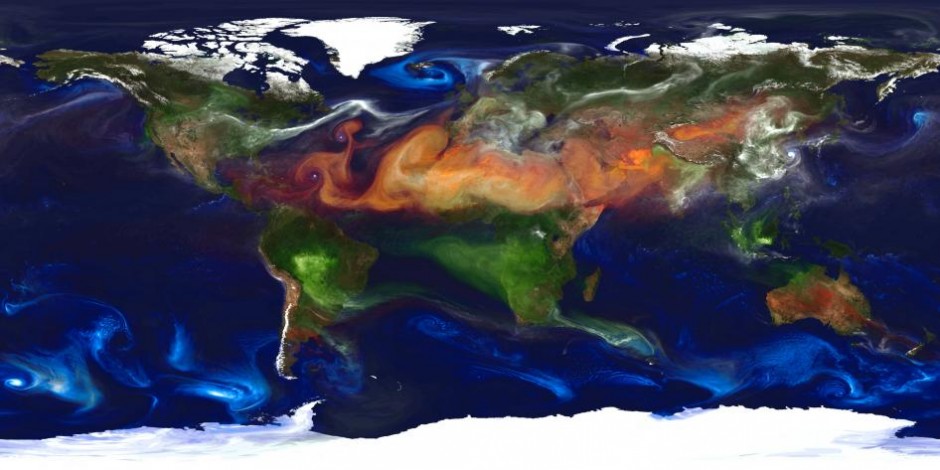Efforts to slow the rate of global temperature rise in the 21st Century have for some time focussed on non-CO2 species or so-called ‘short-lived forcers’. As far as aerosols are concerned, black carbon (often referred to as soot) has been the main avenue to explore due to its capacity to warm the atmosphere by absorbing sunlight. Black carbon contrasts with most other aerosol species which tend to cool the Earth, so reducing emissions of black carbon is attractive as it has the twin benefits of reducing future global temperatures and improving air quality. The hard part is that black carbon tends to get mixed up with other members of the atmospheric aerosol gang, with the outcome being highly uncertain. A recent review concluded that the overall impact of black carbon combined with its co-emitted partners was slightly negative but with huge uncertainties; the estimates ranged from cooling or warming that was comparable to the impact by carbon dioxide! Black carbon and its accomplices could either be offsetting the historical impact of carbon dioxide or adding extra warming on top.
Bearing the above in mind, the idea to slow global warming by reducing black carbon emissions has been around for more than a decade. Thirteen years ago, James Hansen and colleagues proposed reducing emissions of black carbon and non-CO2 greenhouse gases in order to slow the rate of global temperature change due to increasing concentrations of CO2 by 2050. This was soon followed by a somewhat sceptical perspective in Science by Smith et al. that pointed out the difficulties in targeting individual pollutants with emission controls and the large uncertainties associated with aerosols. Mark Jacobson illustrated with a global aerosol simulation that eliminating black carbon and the associated organic aerosol from fossil fuel burning would reduce net warming by 20-45% within a 3-5 year period. For CO2 emissions to have the same effect, they would need to be reduced by a third but the reduction in net warming would take 50-200 years. Tami Bond has contributed some typically thoughtful and thorough articles to the discussion, concluding that despite the large uncertainties, reducing all aerosol emissions from major sources of black carbon will reduce direct climate warming. Furthermore, she showed that the largest benefits can be gained by reducing emissions in developing countries, where a large proportion of the black carbon source occurs.

Transmission electron microscopy (TEM) images of aerosol particles, including black carbon from Posfai et al. (1999). In panel A, the black carbon particles (denoted by the small arrows) are mixed with inorganic ammonium sulphate particles. In panel B, a typical chain-like black carbon aggregate is shown with the arrows pointing to a film of carbon that connects the individual spherules within the aggregate. In panel C, fly-ash spheres are shown, which are particles that are often associated with black carbon particles. The scales give an idea of the size of these particles – a human hair is around 100µm or 100,000nm.
Recently, reducing black carbon emissions has been highlighted by a UNEP report and an associated article in Science, which showed that targeting methane and black carbon emissions could knock off around 0.5°C (with a range of 0.2-0.7°C) by 2050 compared to the current projected temperature rise. This weeks’ Smith et al. paper in PNAS suggested a lower central result of 0.16°C (with a range of 0.04-0.35°C). The large ranges in temperature reduction in both studies were mainly due to the uncertainty in aerosol effects. Coverage of the most recent paper has focussed on the idea that such emission reductions will not “save us from climate change” (e.g. here, here, here and here). While this is very likely true, having read the work in this area, nobody has been suggesting this anyway! For example, Hansen et al. stated:
This interpretation does not alter the desirability of limiting CO2 emissions, because the future balance of forcings is likely to shift toward dominance of CO2 over aerosols.
While Shindell et al. stated:
…eventual peak warming depends primarily on CO2 emissions, assuming air quality–related pollutants are removed at some point before peak warming.
The argument for reducing short-term forcing species has been predicated on slowing global temperature rise over the first half of the 21st Century, not halting it. The potential benefits of this include more time to develop CO2 reducing policies/technologies, slower sea-level rise and reduced warming in susceptible environments, such as the Arctic. These are just some of the climate benefits, with advantages for human health and ecosystems also being highlighted.
The short atmospheric lifetime of black carbon also raises a question mark over whether a global temperature perspective is the most appropriate measure. Unlike the longer-lived greenhouse gases, the climate warming from black carbon is much more regional in nature and it is on these scales that the impacts are most keenly felt. For example, black carbon emissions for energy generation are concentrated in North America, Europe and Asia, so their impact is stronger in the Northern Hemisphere. Emissions from cooking stoves are more prevalent in developing countries in the tropics, while deforestation, which accounts for around a third of black carbon emissions, is also focussed in tropical areas. Consequently, any future policies or technological developments will need to take these into account if a reduction of black carbon emissions is to slow future temperature rises and the potential consequences of this. Whether the science is suitably mature to inform climate policy decisions in this area though remains to be seen; the studies highlighted all point to black carbon exerting a net warming up to 2050 but the magnitude of its effect and the feasibility of reducing emissions is highly uncertain.

Unfortunately, Sweep’s magic wand wasn’t enough to reduce Sooty’s contribution to climate change. Image from here.

